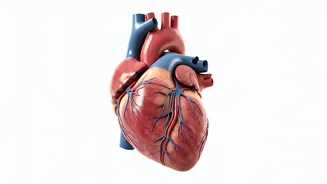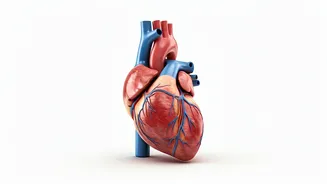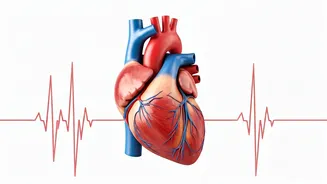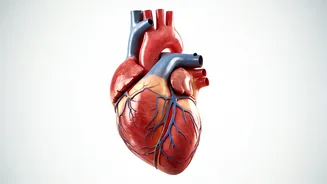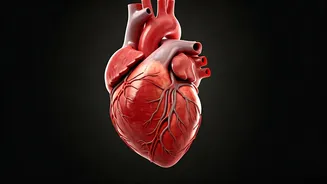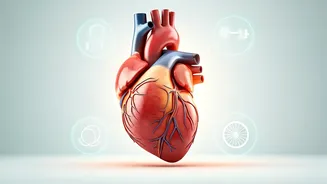Brisk Walking Benefits
Brisk walking is a fundamental exercise, appreciated for its simplicity and remarkable impact on heart health. It is a classic choice, accessible to almost
everyone, requiring no special equipment or training. The beauty of brisk walking lies in its adaptability; it can be integrated into your daily routine effortlessly. Whether it's a quick walk around your neighborhood, a stroll in the park, or a purposeful stride on a treadmill, brisk walking gets your heart rate up, strengthening your cardiovascular system. Consistent brisk walking helps in lowering blood pressure, reducing cholesterol levels, and improving overall heart function. Aim for at least 30 minutes of brisk walking most days of the week to reap these benefits. Varying your pace and terrain adds interest and further challenges your body, enhancing both physical and mental well-being. Walking regularly offers a convenient, low-impact way to improve your heart health and overall quality of life.
Cycling for Heart
Cycling presents another excellent way to boost your heart health, offering versatility through both indoor and outdoor options. Whether you prefer a scenic bike ride outdoors or a spin class indoors, cycling provides a low-impact workout that's gentle on your joints while still providing a robust cardiovascular workout. Outdoor cycling exposes you to fresh air and the changing scenery, turning your workout into an enjoyable experience. Cycling indoors, using stationary bikes, allows you to exercise regardless of weather conditions, and often includes structured workouts with varying resistance levels. The benefits of cycling extend beyond heart health, including improved muscle strength, increased endurance, and effective calorie burning. It enhances the efficiency of your heart and lungs, promoting better blood circulation and oxygenation throughout your body. Aim for consistent cycling sessions, gradually increasing the duration and intensity over time. Cycling is a fantastic exercise for people of all fitness levels who want to improve their cardiovascular health.
Swimming and Water Aerobics
Swimming and water aerobics are exceptionally beneficial, low-impact exercises that are easy on the joints. The buoyancy of water reduces the stress on your body, making it a suitable option for individuals of all ages and fitness levels. Swimming provides a full-body workout that engages multiple muscle groups while increasing your heart rate and improving cardiovascular function. Water aerobics, often conducted in a group setting, involves a variety of exercises performed in the water, such as jogging, jumping jacks, and arm movements. These exercises offer the cardiovascular benefits of exercise while also promoting muscle strength and flexibility. Water-based exercises are particularly advantageous for people with joint pain, arthritis, or other conditions. The resistance of the water provides a challenging workout without putting undue stress on your joints. Participating in swimming or water aerobics on a regular basis supports heart health, increases your fitness levels, and enhances your overall well-being. Consider these water-based activities as enjoyable, effective ways to boost your cardiovascular fitness and improve your quality of life.
Gentle Yoga Practice
Yoga, particularly gentle styles, provides a holistic approach to enhancing heart health. It combines physical postures (asanas), breathing techniques (pranayama), and meditation to improve your cardiovascular well-being. While some may view yoga as solely a stretching exercise, certain styles, such as Hatha or restorative yoga, can gently elevate your heart rate, improving circulation and cardiovascular efficiency. Yoga promotes flexibility, balance, and muscle strength. It is suitable for people of varying fitness levels. The practice of yoga aids in stress reduction and relaxation, and both of these have a direct impact on heart health. Regular yoga practice can lower blood pressure, improve cholesterol levels, and reduce the risk of heart disease. The mindful breathing techniques used in yoga help calm the nervous system. By integrating yoga into your routine, you can promote not only physical health but also mental and emotional wellness, contributing to a healthy heart and overall vitality. Explore different yoga styles to find one that aligns with your needs and preferences, aiming for consistent practice for optimal results.
Dancing for Heart Health
Dancing is a fun, engaging, and often underestimated form of exercise. It offers significant benefits for heart health. Dancing, whether it's structured classes or spontaneous moves, gets your heart pumping, improving cardiovascular function. Dancing involves a variety of movements, from gentle swaying to more vigorous steps, engaging various muscle groups. The social aspect of dancing, if done in a group setting, adds to its benefits, as it promotes mental and emotional well-being. Different dance styles, like Zumba or ballroom dancing, provide varying levels of intensity, allowing you to choose an option that suits your fitness level and preferences. Dancing improves coordination, balance, and flexibility, contributing to physical fitness. Regular dancing can lower blood pressure, reduce cholesterol levels, and decrease the risk of heart disease. It's a joyful way to boost your heart health, making exercise enjoyable and sustainable. Embrace the rhythm and joy of dancing as a key element of your heart-healthy lifestyle, and discover the physical and emotional benefits it offers.
Low-Impact Bodyweight Circuits
Low-impact bodyweight circuits are an efficient way to enhance your cardiovascular health, achievable without needing special equipment or gym memberships. These circuits typically consist of a sequence of exercises that elevate your heart rate while minimizing strain on your joints. Exercises like modified push-ups, squats, lunges, and plank variations form the core of these routines. By using your body weight as resistance, these circuits are accessible to people of all fitness levels. They can be performed in your home, at any time, making exercise convenient. The circuits typically involve a set number of repetitions for each exercise, followed by a short rest period, before repeating the circuit several times. This method offers cardiovascular benefits. Low-impact bodyweight circuits improve your heart health, increase muscle strength, boost endurance, and promote weight loss. These circuits are designed to be adaptable. You can modify the exercises based on your abilities and gradually increase the intensity as you get fitter. Incorporating low-impact bodyweight circuits into your routine is an effective method of heart-healthy exercise.
Tai Chi and Qigong
Tai Chi and Qigong offer gentle, yet impactful ways to improve your heart health, combining mindful movements with deep breathing techniques. These practices involve slow, controlled movements. Tai Chi and Qigong are rooted in ancient Chinese traditions, known for their focus on promoting balance, harmony, and overall well-being. They involve graceful postures, flowing motions, and focused breathing, which can lower stress levels, reduce blood pressure, and enhance cardiovascular function. The slow and deliberate movements of Tai Chi are designed to improve balance, flexibility, and muscle strength, while also providing a calming effect on the nervous system. Qigong involves a variety of exercises, including dynamic and static postures, breathing exercises, and visualization techniques, all of which aim to harmonize your energy flow (Qi) and improve your overall health. These practices are low-impact, making them suitable for people of all ages and fitness levels, including those with mobility issues or chronic conditions. Consistent practice of Tai Chi or Qigong can contribute to better cardiovascular health. By incorporating these practices, you can improve your heart health while promoting mental clarity and inner peace, enhancing your overall well-being.
